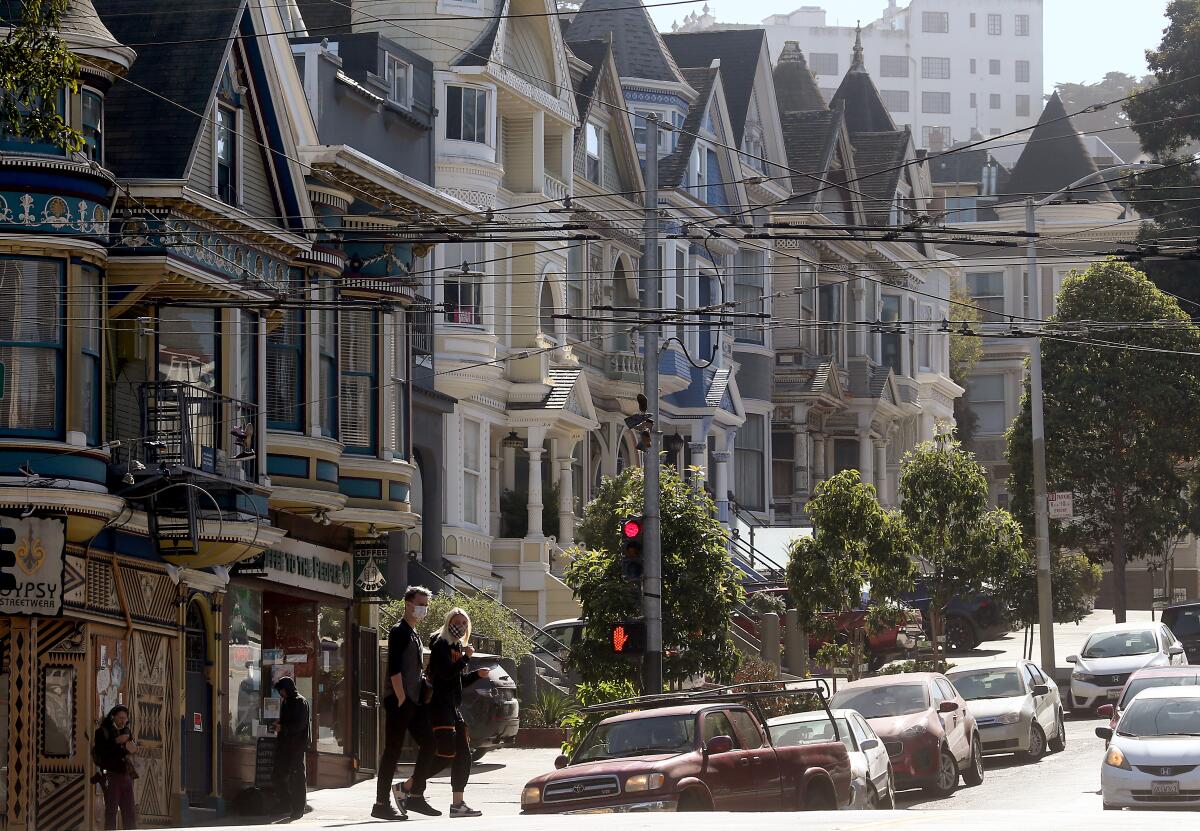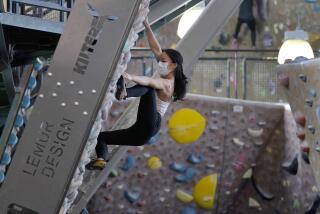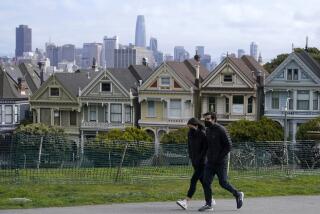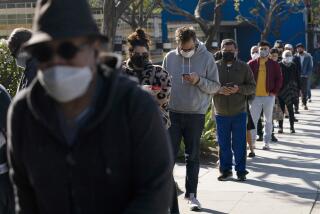San Francisco, long hailed for beating COVID-19, now faces a spike in cases

SAN FRANCISCO — It’s America’s second-densest city. Near the nation’s first recorded COVID-19 death. And home to a busy international airport.
San Francisco has for most of the pandemic managed to keep infection rates and total cases low, in part by following conservative practices, which have slowed its reopening compared with that of other California cities.
But this week, the city faces a dire test of its strategy. Cases have significantly spiked in the last week at a pace worse than that of any previous surge, which has alarmed city officials.
On Tuesday, the city proactively announced the shutdown of indoor restaurant dining, effective Saturday morning. Capacity at gyms and theaters will be reduced, and the city’s high schools will have to wait to reopen for in-person learning as well, officials said, as they try to get the numbers going down again.
San Francisco’s numbers remain much lower than those in other parts of California. San Francisco County ranked 45th among the state’s 58 counties in per-capita cases over the past two weeks. For the duration of the pandemic, San Francisco has reported 17 deaths per 100,000 residents, far fewer than Los Angeles County, with 71 deaths per 100,000 residents.
But the sudden spike in cases could change things dramatically.
Since late October, new daily infections have risen by 150% in San Francisco (the city and county are one and the same). If this pace is not slowed, San Francisco is on track to see its daily number of new coronavirus infections multiply by a factor of 10 — from 32 cases a day in late October to 300 cases daily by the end of the year.
“This suggests much broader virus transmission and has the potential to be explosive,” San Francisco’s public health director, Dr. Grant Colfax, said Tuesday. “If we do not pause, and we do not reverse, it is entirely plausible that we will face a situation where our healthcare system could become overwhelmed.”
The sudden rise places San Francisco in the same boat as many others in California — dealing with spread through social gatherings as fatigue and resentment of the nine-month pandemic persists.
The city’s response to the coronavirus has been far from perfect. It has faced outbreaks among homeless residents. And there has been criticism that it hasn’t done enough to make tests available to Latino residents, as documented by the news website Mission Local.
Still, experts have said San Francisco’s overall record is one to watch for potential lessons. The question is whether this approach will continue to prove successful if California experiences another COVID-19 wave, and people let down their guard during the holidays.
In some ways, the new surge was predictable.
It’s now clear that whenever disease rates get lower, “people take a few more risks,” said Dr. Kirsten Bibbins-Domingo, chair of UC San Francisco’s department of epidemiology and biostatistics.
“We have to be even more cautious when we’re about to engage in activities that can really increase viral transmission,” Bibbins-Domingo said. “And that failing to do that, unfortunately, can quickly get out of control.”
Even with the surge, San Francisco and parts of the Bay Area have fared relatively well in curbing COVID-19 so far, and that has sparked some in the medical community to say the region should be an example for other areas.
Here are some things that have worked well:
Support for masks
In Southern California, some communities vociferously oppose mandatory masks. Some elected officials have publicly pressured the state to allow counties to permit businesses to reopen faster.
But in the Bay Area, mask wearing in public has been the social norm for months, and key political leaders have largely backed the county health officials who devised the nation’s first regional stay-at-home order.
“A greater proportion of the population is wearing masks. And a greater proportion of the population is abiding by the recommendations,” said Dr. George Rutherford, epidemiologist and infectious diseases expert at UC San Francisco. “That’s the most likely explanation.”
“When you go outside, people are wearing masks. When you are in an Uber car, they have their windows open,” Bibbins-Domingo said. “People are paying attention to those things.”
A slower reopening
San Francisco and its neighboring counties have been extraordinarily cautious in their reopening timelines, allowing businesses to resume on a slower timeline than allowed by the state.
“We want to be able to stay ahead of the virus. By the time you have lots of cases and try to catch up, the healthcare systems are often overwhelmed. And that’s where you see more devastation from this virus,” Colfax said in an interview just before Halloween.
In the summertime, Bay Area counties generally moved more slowly in reopening businesses than Southern California.
In L.A. County, bars opened up on June 19 and were ordered shut June 28 as cases quickly rose. San Francisco never reopened bars that didn’t serve meals.
That may have played a role in why the Southern California summer surge was far worse than that of Northern California, before Gov. Gavin Newsom issued another set of orders closing indoor operations of businesses again in late June and early July.
Nearby Santa Clara County, home to Silicon Valley, has also taken a conservative reopening approach. The county is in the second-least restrictive tier according to the state’s reopening rules, so it is allowed to reopen Levi’s Stadium to spectators for up to 20% capacity.
But the county decided to keep the venue, where the San Francisco 49ers play, closed to fans for the foreseeable future.
Los Angeles County, meanwhile, which is in the most restrictive tier in the state’s reopening rubric, has no option for allowing spectators to return to sports stadiums.
Smaller counties for the Bay Area
The smaller counties of the Bay Area may also have helped in managing the pandemic. The Bay Area has 7.7 million people but is governed by health officials from nine counties and the city of Berkeley, while most of Los Angeles County’s 10 million residents are overseen by one public department (Long Beach and Pasadena have their own public health departments).
As a result, San Francisco’s public health department only needs to worry about managing the public health of fewer than 900,000 residents.
“The Southern California counties are huge,” Rutherford said. “You can kind of divide the problem up a little bit.”
So when reopenings happen in Los Angeles County, that means a single agency is managing the reopening of 40,000 restaurants and 15,000 hair and nail salons, said Barbara Ferrer, director of public health in Los Angeles County.
“The magnitude of the work that needs to happen with all of our reopenings is far different than what it is in any other county,” she said. “It requires both a lot more work on the part of all of the different sectors that are reopening. Because little mistakes get amplified very quickly because they can happen in so many different places.”
Sweeping power for local health officers
Longstanding California law that gives sweeping powers to local governments has also helped.
In some states, governors have battled with local leaders over who gets the final say over a health order to, say, mandate the wearing of masks. Sometimes, governors have ordered local officials to back off of strict pandemic orders.
In California, the law gives local health officers wide-ranging powers to make decisions to protect their community, Dr. Sara Cody, the Santa Clara County health officer, said recently. That helped to enable her and her counterparts in Bay Area counties to implement the nation’s first regional stay-at-home pandemic order, a version of which was adopted statewide days later by the governor.
“I do think that that early action enabled us to suppress the amount of community transmission early on,” Cody told a meeting of the Silicon Valley Leadership Group.
Expanding testing to underserved areas
San Francisco has expanded testing widely and made hotels available for people who need isolation or quarantine if they’ve been infected or exposed to someone who has tested positive and can’t do so at home, Colfax said in the interview.
Colfax also credited San Francisco’s mobile testing and an array of disease investigators who trace the contacts of the newly infected among communities of color. Latinos are still testing positive at greater rates than San Francisco residents as a whole, but there has been progress: In July, 13% of Latino residents being tested had positive test results; in the first couple of weeks of October, it was down to 3%, Colfax said.
“It’s still higher than the general population, but it’s certainly moving in the right direction,” Colfax said.
Officials said that by the late summer, as the pandemic’s impact on Latino residents became clear, testing resources were focused on areas with the highest infection rates. There’s increased focus in underserved communities, and officials have partnered with Black, Latino and Samoan organizations to reach out to residents who may be mistrustful of government, have limited English-speaking ability or who might be in the country illegally.
“It’s about low-barrier testing. And it’s also about combining that low-barrier testing with the prevention and education efforts around masking,” Colfax said. “And it’s about working with agencies that provide social and support services.”
Times staff writers Susanne Rust and Maura Dolan contributed to this report.
More to Read
Sign up for Essential California
The most important California stories and recommendations in your inbox every morning.
You may occasionally receive promotional content from the Los Angeles Times.











